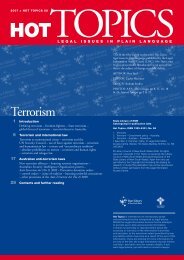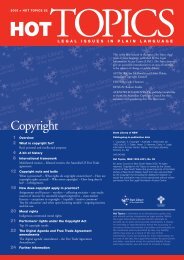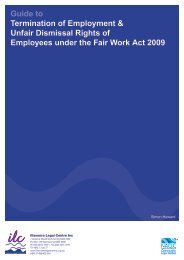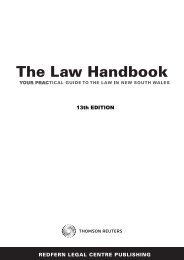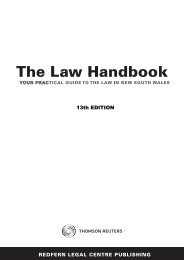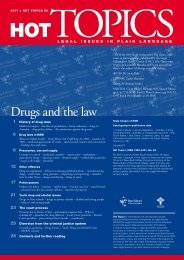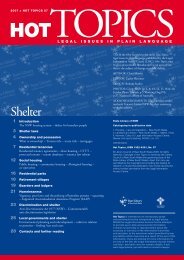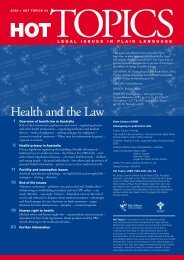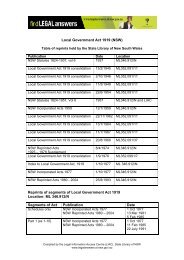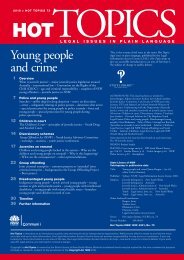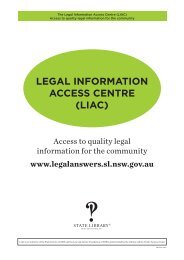Prisoners - Legal Information Access Centre - NSW Government
Prisoners - Legal Information Access Centre - NSW Government
Prisoners - Legal Information Access Centre - NSW Government
You also want an ePaper? Increase the reach of your titles
YUMPU automatically turns print PDFs into web optimized ePapers that Google loves.
Imprisonment<br />
in <strong>NSW</strong><br />
92<br />
lAWs And pOlicies<br />
Listed below are some of the main pieces of legislation that<br />
currently apply to prisoners and imprisonment in <strong>NSW</strong><br />
which can be accessed from the <strong>NSW</strong> Parliamentary<br />
Counsel’s Office website at www.legislation.nsw.gov.au<br />
Note: For more critical accounts of how some of these<br />
various legal regulations apply in practice: see Sydney<br />
Morning Herald Special Investigation, ‘Captive State’,<br />
SMH, 6-11 December 2008.<br />
acts<br />
> Crimes (Administration of Sentences) Act 1999 (<strong>NSW</strong>) –<br />
includes general obligations of inmates, circumstances<br />
for segregation or protective custody, management of<br />
juvenile inmates, circumstances for transfers.<br />
> Crimes (Sentencing Procedure) Act 1999 (<strong>NSW</strong>) –<br />
covers areas such as the purposes of sentencing and the<br />
types of penalties that may be imposed (custodial and<br />
non-custodial), fines, sentencing procedures, victim<br />
impact statements, and sentencing guidelines.<br />
> Summary Offences Act 1988 (<strong>NSW</strong>) – sets out many<br />
offences which may lead to imprisonment; they are<br />
generally considered less serious offences and can be<br />
dealt with by a local court.<br />
> Crimes Act 1900 (<strong>NSW</strong>) – deals with the more serious<br />
offences including homicide, assault, sexual assault,<br />
kidnapping, explosives and firearms offences, theft,<br />
fraud, property crimes, blackmail, forgery, terrorism<br />
and animal cruelty, as well as defences to criminal<br />
responsibility.<br />
> Crimes (Serious Sex Offenders) Act 2006 (<strong>NSW</strong>) –<br />
covers extended supervision orders and continuing<br />
detention orders for serious sex offenders.<br />
> Bail Act 1978 (<strong>NSW</strong>) covers the circumstances<br />
where bail will or will not be considered, which has<br />
implications for the numbers on remand (see page 3).<br />
> Fines Act 1996 (<strong>NSW</strong>) – deals with the circumstances<br />
under which non-payment of fines can lead to<br />
imprisonment.<br />
> Crimes (Interstate Transfer of Community Based<br />
Sentences) Act 2004 (<strong>NSW</strong>).<br />
> <strong>Prisoners</strong> (Interstate Transfer) Act 1982 (<strong>NSW</strong>).<br />
> Parole Orders (Transfer) Act 1983 (<strong>NSW</strong>).<br />
> International Transfer of <strong>Prisoners</strong> Act (New South<br />
Wales) 1997.<br />
Regulations<br />
> Crimes (Administration of Sentences) Regulation<br />
2008 (<strong>NSW</strong>) – deals with the detail of admission<br />
classification, case management, correctional centre<br />
routine, searching, food, cleanliness, inmate services,<br />
chaplaincy, visits, written communications, discipline,<br />
offences, release procedure, periodic detention, home<br />
detention, staff obligations and many other matters.<br />
> <strong>Prisoners</strong> (Interstate Transfers) Regulation 2004.<br />
> Crimes (Interstate Transfer of Community Based<br />
Sentences) Regulation 2004.<br />
The Crimes (Administration of Sentences) Act and<br />
corresponding Regulation cover many more areas of<br />
prison life. In addition, the Department of Corrective<br />
Services publishes a Policy and Procedure Manual.<br />
prisOns in nsW<br />
The <strong>NSW</strong> Department of Corrective Services, headed<br />
by a Commissioner is responsible for:<br />
> 31 correctional centres – 8 maximum, 13 medium and<br />
10 minimum security facilities;<br />
> 8 periodic detention centres;<br />
> 1 transitional centre for female inmates;<br />
> 65 probation and parole district offices.<br />
Only one <strong>NSW</strong> prison (Junee) is privately run as at<br />
January 2009, however the <strong>NSW</strong> government has<br />
announced plans to privatise prisons at Parklea and<br />
Cessnock. The <strong>NSW</strong> Legislative Council will hold an<br />
inquiry into the proposal. 93<br />
Correctional centres are divided into four types, however,<br />
some centres cover more than one type of security<br />
classification.<br />
92. Most of the information in this section has been drawn from the legislation as accessed in January 2009 from the Parliamentary Counsel’s<br />
website www.legislation.nsw.gov.au, from the Department of Corrective Services website www.dcs.nsw.gov.au and from the May 2008 version<br />
of the manual.<br />
93. ‘Upper house inquiry into prison privatisation plan’ 15 December 2008 http://www.abc.net.au/news/stories/2008/12/15/2446150.htm<br />
22<br />
HOT TOPICS 67 > <strong>Prisoners</strong>



